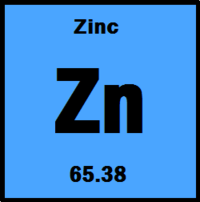Zinc
Zinc is the 30th element on the periodic table. It is a silvery-white metal that tarnishes in air, and has many uses in society. Zinc is the 4th most common metal in use, next to iron, aluminum and copper.
Over 13 million tonnes of zinc are produced worldwide each year, primarily in China, Australia, and Peru.[2] Considering the embodied energy in zinc production is, on average, between 49-55 MJ/kg, this puts the total annual energy required to produce zinc between 637-715 petajoules (1015 joules).[3]
Some useful properties of zinc include:[4]
| Atomic weight | 65.38 |
| Density (at 0oC) | 7.134 g/cm3 |
| Boiling point | 1180 K |
| Melting point | 692.68 K |
| Embodied energy[3] | 49-55 MJ/kg |
Uses of Zinc
Roughly a third of all zinc is used to galvanize other metals - this means it protects the metal from rusting. An object such as an iron nail is protected from corrosion by giving it a protective layer of zinc. Galvanized steel is used for car bodies, street lamp posts, and suspension bridges.[5]
Zinc is also used to make useful alloys such as brass, where it is mixed with up to 95% copper. Brass is a very common alloy, and was used more than 2500 years ago by the Ancient Romans. Today, brass is used to make musical instruments, screws and other hardware.[4] Zinc is also alloyed with lead and tin to make solder, used in joining electrical pieces together such as pairs of copper wire.
Zinc has also long been used in batteries, due to its high power density and excellent electrochemical properties. Newer zinc batteries are also rechargeable, as well as being recyclable.[6]
In living things
Zinc is essential for life, as it forms the site for over 20 metallo-enzymes. The average human contains around 2.5 grams of zinc at any one time, and intakes around 15 milligrams per day from foods such as beef, lamb, or cheese.[5]
Too much zinc is dangerous however, as it can be carcinogenic in excess.
Video
The video below is from the University of Nottingham's periodic videos project.[7] They have created a complete suite of short videos on every element on the periodic table of elements.
References
- ↑ Made internally be a member of the Energy Education team, with information from Jefferson Labs, Available: http://education.jlab.org/itselemental/ele030.html
- ↑ Tolcin, A. C. (2015). Mineral Commodity Summaries 2015: Zinc (PDF). United States Geological Survey. Retrieved May 27, 2015. Available: http://minerals.usgs.gov/minerals/pubs/commodity/zinc/mcs-2015-zinc.pdf
- ↑ 3.0 3.1 UNEP. (August 19, 2015). Environmental Risks and Challenges of Anthropogenic Metals Flows and Cycles [Online]. Available: https://d396qusza40orc.cloudfront.net/metals/3_Environmental_Challenges_Metals-Full%20Report_36dpi_130923.pdf#96
- ↑ 4.0 4.1 Jefferson Labs. (Accessed May 17, 2016). The Element Zince [Online], Available: http://education.jlab.org/itselemental/ele030.html
- ↑ 5.0 5.1 Royal Society of Chemistry. (Accessed May 18, 2016). Zinc [Online], Available: http://www.rsc.org/periodic-table/element/30/zinc
- ↑ International Zinc Association. (Accessed May 23, 2016). Batteries [Online], Available: http://www.zinc.org/batteries/
- ↑ See more videos from the University of Nottingham on different elements here: http://www.periodicvideos.com/


